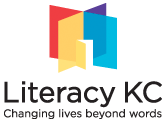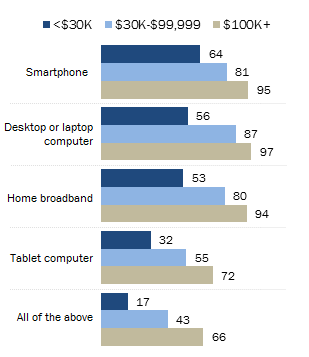As practitioners and leaders across the country recognize the importance of digital equity this week for National Digital Inclusion Week, Literacy KC is proud to be an active participant in this conversation and supporter of this movement. We try to tackle all three parts of digital inclusion at our organization: access, devices, and digital literacy training. We offer digital literacy classes for students and community members because we recognize the importance of digital skills training for advancement in literacy. We have a computer lab that is open to the public during our business hours because we know people often need a place to use the computer. We help our students access discounted devices and Internet.
Today, though, we want to focus on one element of digital inclusion: the importance of having the right device.
When you stop to consider how many devices you own to access the Internet, for some of us the number can get pretty high. You might have a laptop to type reports and send emails, a tablet to read the latest articles, and a smartphone to listen to music and post to Facebook or Twitter. You might even have a way to access the Internet through your TV!

While it can be really convenient to have a screen large enough for the task at hand, having multiple devices is also a luxury. In fact, having multiple devices to connect to the Internet is often tied to income. According to Pew Research, “Higher-income Americans are also more likely to have multiple devices that enable them to go online. Two-thirds of adults living in high-earning households have home broadband services, a smartphone, a desktop or laptop computer and a tablet, compared with 17% of those living in low-income households.”
With fewer options to get online, many lower income Americans have to rely on smartphones as their only device. In fact, many are smartphone-only users, meaning they do not have broadband Internet at home.
This means that a smartphone may be the only device they have to do the tasks that many of us will switch over to a larger screen for, such as job searching and applications, reading an online textbook or doing homework. This also means that they may not have any familiarity with how to use a keyboard or mouse, which are vital tasks for being able to navigate a computer.
This unfamiliarity with a keyboard and mouse is something I experienced firsthand with our students at Literacy KC. When I first developed our digital program, I did not realize that starting at square one would mean learning how to type and use a mouse. But of course if an individual has not used a device other than a smartphone, then they would not necessarily be familiar with the keyboard keys, using a mouse, or how to open up the web browser and type in a web address.
While having a smartphone is certainly better than nothing, it can also make it difficult to complete certain tasks online. Not being familiar with a desktop or laptop can also stunt someone’s confidence to learn more about computers, which can then hurt them in their future opportunities for education and career advancements.
But what do we do when the reality is that many Americans, including many of our students at Literacy KC, simply cannot afford to own more than one device, if any at all? At Literacy KC we try to help our students afford refurbished, discounted computers by providing scholarships through our Student Needs Committee that students can put toward a laptop or a hotspot. We have an open computer lab where students can practice typing and using a mouse and getting more comfortable using a computer while they save up to buy their own. As practitioners, we should be advocating for technology, apps, and mobile websites that make it easier for smartphone-only users. As fellow citizens we should recognize that there are still many individuals who do not have the luxury of multiple devices to complete digital-related tasks.
Digital inclusion and digital equity are important topics that should be discussed year round. But this week, as we place special emphasis on the issue, we should remember that not everyone has the same luxury to juggle multiple devices for their different tasks, and to remember that being connected can mean a variety of things for different individuals.
By Sarah Bell, Literacy KC Digital Inclusion Fellow- sbell@literacykc.org

